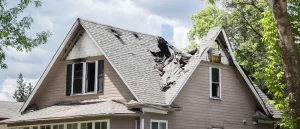Storms are powerful natural events that can cause widespread destruction in a matter of minutes. From heavy rainfall and strong winds to hail, lightning, and even tornadoes or hurricanes, storms can leave a trail of damage to homes, businesses, and landscapes. Understanding storm damage, its impact, and how to recover from it is essential for both property owners and communities.
What is Storm Damage?
Storm damage refers to the destruction or deterioration of property and natural environments caused by severe weather events. Common types of storms that cause damage include:
- Thunderstorms: Often bring high winds, lightning, and heavy rain.
- Tornadoes: Can destroy buildings and uproot trees with extreme winds.
- Hurricanes: Cause massive flooding, wind damage, and coastal erosion.
- Winter Storms: Lead to ice accumulation, heavy snow, and freezing temperatures.
- Hailstorms: Damage roofs, windows, vehicles, and crops.
Common Types of Storm Damage
1. Wind Damage
High winds can tear off roofs, break windows, and bring down trees and power lines. Even moderately strong gusts can turn unsecured items into dangerous projectiles.
2. Water and Flood Damage
Storms often bring heavy rain, which can cause flash flooding and water intrusion in homes and buildings. Floodwaters may damage foundations, walls, electrical systems, and personal belongings.
3. Hail Damage
Hailstones vary in size but can be extremely destructive. They can dent cars, crack shingles, break windows, and destroy crops.
4. Lightning Damage
Lightning strikes can cause fires, power outages, and severe electrical damage. It can also pose serious risks to people and animals.
5. Structural Damage
Powerful storms, especially hurricanes and tornadoes, can cause buildings to collapse or become unsafe for occupancy.
Effects of Storm Damage
- Economic Loss: Repairing damaged properties, replacing destroyed items, and loss of business can be financially overwhelming.
- Emotional Stress: Dealing with a damaged home or the loss of sentimental items can take a psychological toll on individuals and families.
- Environmental Impact: Trees, wildlife habitats, and ecosystems may suffer significant disruption.
- Public Safety Hazards: Downed power lines, debris, and contaminated floodwaters pose risks to community safety.
Preventing and Minimizing Storm Damage
While storms can’t be prevented, steps can be taken to minimize their impact:
- Install Storm-Resistant Features: Use impact-resistant windows, reinforce roofing, and install shutters.
- Secure Outdoor Items: Anchor or bring inside loose furniture, decorations, or tools.
- Maintain Trees and Roofs: Regular maintenance reduces the chance of falling branches and structural damage.
- Develop an Emergency Plan: Know evacuation routes, have emergency kits ready, and stay informed through weather alerts.
What to Do After Storm Damage
- Ensure Safety: Check for injuries, downed power lines, and gas leaks. Avoid flooded areas.
- Document the Damage: Take photos and videos for insurance purposes.
- Contact Your Insurance Company: File a claim as soon as possible.
- Make Temporary Repairs: Cover broken windows or roof holes to prevent further damage.
- Hire Licensed Contractors: Avoid scams by working with reputable professionals for repairs.
Final Thoughts
Storm damage can be devastating, but being prepared and knowing how to respond can make recovery faster and less stressful. Investing in storm protection and creating a solid emergency plan are key steps in protecting yourself, your family, and your property.




